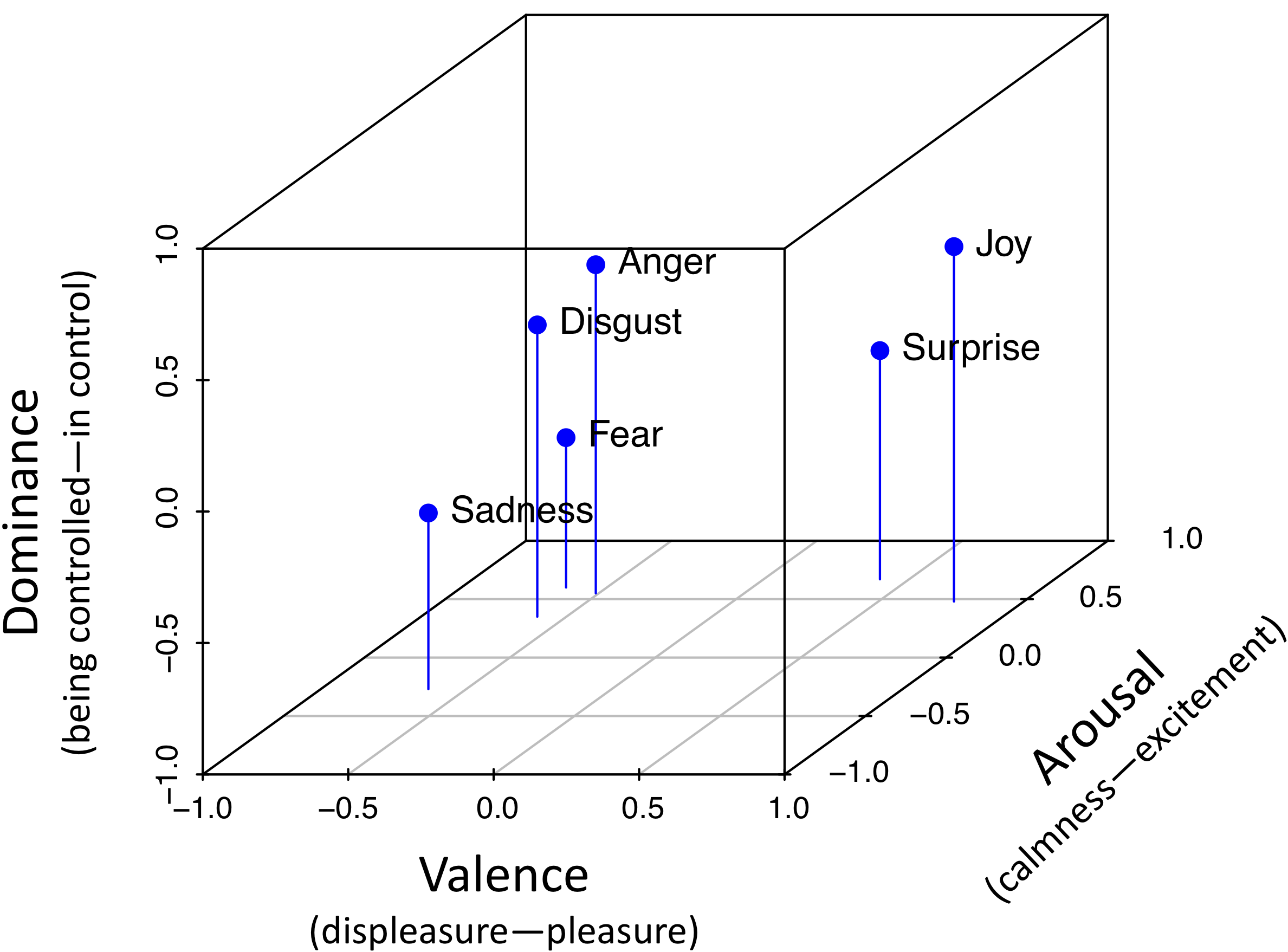JeSemE
We stopped offering the online version of JeSemE here. This is a placeholder site derived from the help site provided as part of JeSemE. The interactive app is available on Github and ready for self-hosting in a trusted environment: github.com/JULIELab/JeSemE and the necessary models are linked at the bottom of this page. This site differs from the variant in the Github repository by providing resources like CSS styleheets and JavaScript from the university's servers for privacy regulation compliance.
JeSemE is described in detail in our COLING 2018 paper "JeSemE: A Website for Exploring Diachronic Changes in Word Meaning and Emotion" and our ACL 2017 paper "Exploring Diachronic Lexical Semantics with JESEME", the following is a simplified overview.
Metrics
VAD Emotions
The Valence Arousal Dominance (VAD) model of emotion assumes that affective states can be described relative to three emotional dimensions, i.e., Valence (corresponding to the concept of polarity, see above), Arousal (the degree of excitement or calmness) and Dominance (feeling in or out of control of a social situation). Emotion values for historical texts are calculated by combining word embeddings and contemporary emotion lexicons, see "Inducing Affective Lexical Semantics in Historical Language" for details. The following illustration shows the three-dimensional VAD space with the position of several emotion words.

PPMI and χ2
Both Positive Pointwise Mutual Information (PPMI) and Pearson's χ2 measure how specific a combination of two words is. Both use the frequency of a word \(i\) or context word \(j\) to calculate the probability of finding one of them, as in \(P(i)\) respectively \(P(j)\).They then compare the expected probability of encountering both words \(P(i)P(j)\) with the observed frequency/probability \(P(i,j)\). Resulting values are normalized, so all associations for a word sum up to 1. JeSemE provides only values above 0.01, due to storage constraints.
PPMI favors infrequent context words and can be calculated with: $$PPMI(i,j) := max(log\frac{P(i,j)}{P(i)P(j)},0)$$
χ2 is regarded as more balanced, we use a normalized version calculated with: $$\chi^2(i,j) := max(log\frac{(P(i,j) - P(i)P(j))^2}{P(i)P(j)},0)$$
SVDPPMI
SVDPPMI uses singular value decomposition (SVD) to reduce the dimensionality of a matrix storing PPMI data. It produces word embeddings with quality similar to word2vec embeddings. See Levy (2015) for details. In contrast to word2vec, it is not affected by random initialization based realiability problems, see our papers "Bad Company—Neighborhoods in Neural Embedding Spaces Considered Harmful" and "Don’t Get Fooled by Word Embeddings—Better Watch their Neighborhood" for details.
Corpora
COHA
Corpus of Historical American English, representative and balanced. Lowercased during preprocessing. See here for more information.
DTA
Deutsches Textarchiv 'German Text Archive', a representative (yet only vaguely balanced) corpus of ca. 1600-1900 German. Lemmatized during preprocessing. See here for more information in German.
Google Books
The Google Books Ngram corpus covers about 6% of all books. We use the English Fiction and German subcorpus. It is unbalanced and known for sampling bias. English Fiction lowercased during preprocessing, German lemmatized and lowercased. See here for Google's visualization.
Royal Society Corpus
The Royal Society Corpus (RSC) contains the first two centuries of the Philosophical Transactions of the Royal Society of London. The corpus was lemmatized and lowercased during preprocessing. See here for its homepage.
Corpus Statistics
| Corpus | Years | Segments | Modeled Words | Corpus Size |
|---|---|---|---|---|
| COHA | 1830-2009 | 18 | 5,101 | 376M tokens |
| DTA | 1751-1900 | 5 | 5,347 | 81M tokens |
| Google Books Fiction | 1820-2009 | 19 | 6,492 | 14.7G 5-grams |
| Google Books German | 1830-2009 | 18 | 4,450 | 5.25G 5-grams |
| RSC | 1750-1869 | 3 | 3,080 | 24.7M tokens |